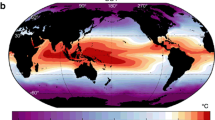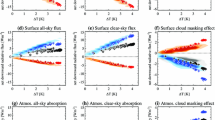Abstract
The general circulation model (GCM) used in this study includes a prognostic cloud scheme and a rather detailed radiation scheme. In a preceding paper, we showed that this model was more sensitive to a global perturbation of the sea surface temperatures than most other models with similar physical parametrization. The experiments presented here show how this feature might depend on some of the cloud modelling assumptions. We have changed the temperature at which the water clouds are allowed to become ice clouds and analyzed separately the feedbacks associated with the variations of cloud cover and cloud radiative properties. We show that the feedback effect associated with cloud radiative properties is positive in one case and negative in the other. This can be explained by the elementary cloud radiative forcing and has implications concerning the use of the GCMs for climate sensitivity studies.
Similar content being viewed by others
References
Cess RD, Potter GL (1988) A methodology for understanding and intercomparing atmospheric climate feedback processes in general circulation models. J Geophys Res 93(D):8305–8314
Cess RD, Potter GL, Blanchet JP, Boer GJ, Del Genio AD, Dé-equé M, Dymnikov V, Galin V, Gates WL, Ghan SJ, Kiehl JT, Lacis AA, Le Treut H, Li ZX, Liang XZ, McAvaney BJ, Meleshko VP, Mitchell JFB, Morcette JJ, Randall DA, Rikus L, Roeckner E, Royer JF, Schlese U, Sheinin DA, Slingo A, Sokolov AP, Taylor KE, Washington WM, Wetherald RT, Yagai I, Zhang MH (1990) Intercomparison and interpretation of climate feedback processes in 19 atmospheric general circulation models. J Geophys Res 95(D) 16601–16615
Heise E, Roeckner E (1990) The performance of physically based cloud schemes in general circulation models. Beitr Phys Atmosph 63:1–14
Le Trent H, Li ZX (1988) Using Meteosat data to validate a prognostic cloud generation scheme. Atmos Res 21:273–292
Le Treut H, Li ZX (1991) Sensitivity of an atmospheric general circulation model to prescribed SST changes: feedback effects associated with the simulation of cloud optical properties. Clim Dyn 5:175–187
Li ZX, Le Trent H (1989) Comparison of GCM results with data from operational meteorological satellites. Ocean-Air Interactions 1:221–237
Li ZX, Le Trent H (1990) Sensitivity analysis with a 1-D climate model. Chinese J Atmos Sci 14:72–82 (Chinese version); 87–99 (English version)
Mitchell JFB, Senior CA, Ingram WJ (1989) CO2 and climate: a missing feedback?. Nature 341:132–134
Platt CMR (1989) The role of cloud microphysics in high-cloud feedback effects on climate change. Nature 341:428–429
Ramanathan V, Cess RD, Harrison EF, Minnis P, Barkstrom BR, Ahmad E, Hartmann D (1989) Cloud-radiative forcing and climate; results from the earth radiation budget experiment. Science 243:57–63
Roeckner E, Schlese U, Biercamp J, Loewe P (1987) Cloud optical depth feedbacks and climate modelling. Nature 329:138–140
Sadourny R, Laval K (1984) January and July performance of the LMD general circulation model. In: Berger A, Nicolis C (eds) New perspectives in climate modelling. Elsevier, Amsterdam
Schlesinger ME, Mitchell JFB (1987) Climate model simulations of the equilibrium climatic response to increased carbon dioxide. Rev Geophys 25:760–798
Smith RNB (1990) A scheme for predicting layer clouds and their water content in a general circulation model. Quart J Roy Meteor Soc 116:435–460
Somerville RCJ, Remer LA (1984) Cloud optical thickness feedbacks in the CO2 climate problem. J Geophys Res 89(D): 9668–9672
Somerville RCJ, Iacobellis S (1987) Cloud-radiation interactions: effects of cirrus optical thickness feedbacks. J Meteor Soc Japan special issue: short and medium range numerical weather prediction, Matsuno T (ed). pp. 177-185
Starr DO'C, Cox SK (1985) Cirrus clouds. part I: a cirrus cloud model. J Atmos Sci 42:2663–2681
Stephens GL, Tsay SC, Stackhouse PW, Flatau PJ (1990) The relevance of the microphysical and radiative properties of cirrus clouds to climate and climate feedbacks. J Atmos Sci 47:1742–1753
Sundqvist H (1981) Prediction of stratiform clouds: Results of a 5-day forecast with a global model. Tellus 33:242–253
Wetherald RT, Manabe S (1988) Cloud feedback processes in a general circulation model. J Atmos Sci 45:1397–1415
Wilson CA, Mitchell JFB (1987) A doubled CO2 climate sensitivity experiment with a global climate model including a simple ocean. J Geophys Res 92(D): 13 315–13 343
Yu W, Sèze G, Le Treut H, Desbois M (1991) Comparison of radiance fields observed from satellite and simulated by the LMD general circulation model. Dyn Atmos Oceans 16:147–165
Author information
Authors and Affiliations
Rights and permissions
About this article
Cite this article
Li, ZX., Le Treut, H. Cloud-radiation feedbacks in a general circulation model and their dependence on cloud modelling assumptions. Climate Dynamics 7, 133–139 (1992). https://doi.org/10.1007/BF00211155
Received:
Accepted:
Issue Date:
DOI: https://doi.org/10.1007/BF00211155




